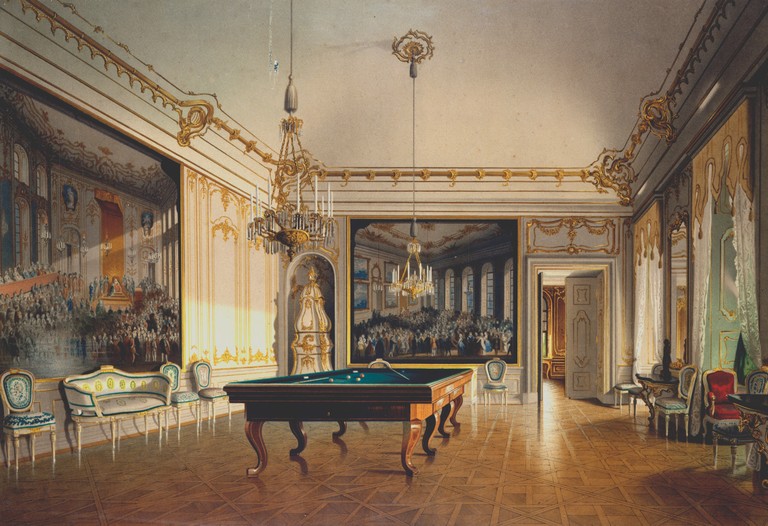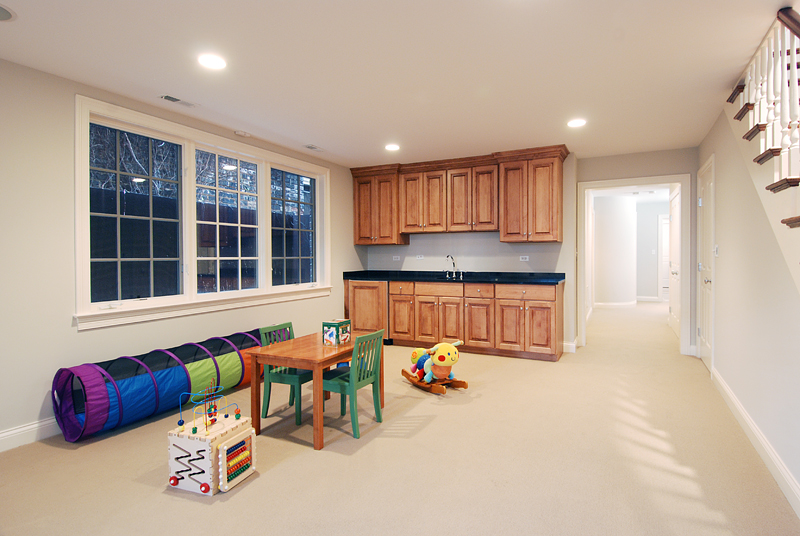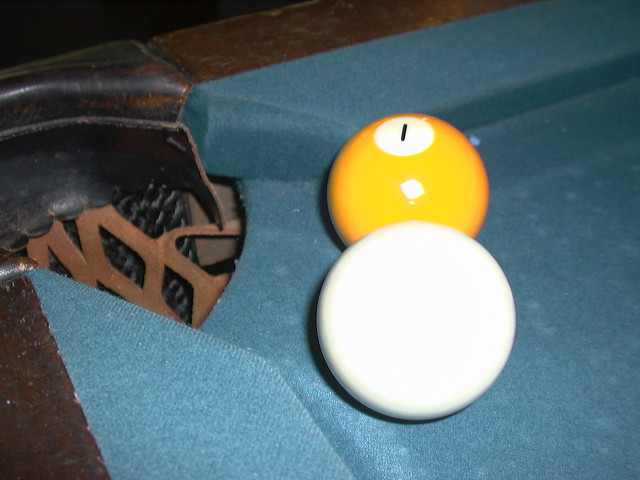|
Pool Room
A billiard room (also billiards room, or more specifically pool room, snooker room) is a recreation room, such as in a house or recreation center, with a billiards, pool or snooker table. (The term "billiard room" or "pool room" may also be used for a business providing public billiards tables; see billiard hall.) The billiard room may be in the public center of the house or the private areas of the house. Billiard rooms require proper lighting and clearances for game playing. Although there are adjustable cue sticks on the market, 5 feet of clearance around the pool table is ideal. Interior designer Charlotte Moss believed that "a billiard room is synonymous with group dynamics. It's where you mix drinks and embark on a little friendly competition..." History Billiards probably developed from one of the late-14th century or early-15th century lawn games in which players hit balls with sticks. The earliest mention of pool as an indoor table game is in a 1470 inventory list ... [...More Info...] [...Related Items...] OR: [Wikipedia] [Google] [Baidu] |
Franz Heinrich 001
{{disambiguation ...
Franz may refer to: People * Franz (given name) * Franz (surname) Places * Franz (crater), a lunar crater * Franz, Ontario, a railway junction and unorganized town in Canada * Franz Lake, in the state of Washington, United States – see Franz Lake National Wildlife Refuge Businesses * Franz Deuticke, a scientific publishing company based in Vienna, Austria * Franz Family Bakeries, a food processing company in Portland, Oregon * Franz-porcelains, a Taiwanese brand of pottery based in San Francisco Other uses * ''Franz'' (film), a 1971 Belgian film * Franz Lisp, a dialect of the Lisp programming language See also * Frantz (other) * Franzen (other) * Frantzen (other) Frantzen or Frantzén is a surname. It may refer to: * Allen Frantzen (born 1947/48), American medievalist * Björn Frantzén (born 1977), Swedish chef and owner of the Frantzén restaurant * Jean-Pierre Frantzen (1890–1957), Luxembourgian gymna ... [...More Info...] [...Related Items...] OR: [Wikipedia] [Google] [Baidu] |
Recreation Room
A recreation room (also known as a rec room, rumpus room, play room, playroom, games room, or ruckus room) is a room used for a variety of purposes, such as parties, games and other everyday or casual activities. The term ''recreation room'' is common in the United States, while the term ''rumpus room'' is common in Australia, New Zealand and Canada; in the United Kingdom, the preferred term is ''games room''. Often children and teenagers entertain their friends in their home's rec room, which is often located in the basement, away from the main living areas of the house. Usually it is a larger space than a living room, enabling the area to serve multiple purposes and entertain moderately large groups. Contents Recreation rooms can have many themes and contents, depending on their intended use. Entertainment Recreation rooms are normally centered on some form of entertainment, typically an audio/video setup. This can consist of something as elaborate as a projection screen w ... [...More Info...] [...Related Items...] OR: [Wikipedia] [Google] [Baidu] |
Billiards Table
A billiard table or billiards table is a bounded table (furniture), table on which cue sports are played. In the modern era, all billiards tables (whether for carom billiards, Pool (cue sports), pool, Russian pyramid, pyramid or snooker) provide a flat surface usually made of quarried slate, that is covered with cloth (usually of a tightly woven worsted wool called baize), and surrounded by vulcanized rubber cushions, with the whole thing elevated above the floor. More specific terms are used for specific sports, such as snooker table and pool table, and different-sized billiard balls are used on these table types. An obsolete term is billiard board, used in the 16th and 17th centuries. Parts and equipment Cushions Cushions (also sometimes called "rail cushions", "cushion rubber", or rarely "bumpers") are located on the inner sides of a table's wooden . There are several different materials and design philosophies associated with cushion rubber. These cushions are made from an ... [...More Info...] [...Related Items...] OR: [Wikipedia] [Google] [Baidu] |
Billiard Hall
A billiard, pool or snooker hall (or parlour, room or club; sometimes compounded as poolhall, poolroom, etc.) is a place where people get together for playing cue sports such as pool, snooker or carom billiards. Such establishments commonly serve alcohol and often have arcade games, slot machines, card games, darts, foosball and other games. Some billiard halls may be combined or integrated with a bowling alley. History Pool and billiards developed as in indoor option for games such as croquet which were played on lawns. Dedicated venues began to appear in the 19th century, and by the early 20th century, billiard and pool halls were common in many countries; in 1915 there were 830 in Chicago. In North America in the 1950s and 1960s especially, pool halls in particular were perceived as a social ill by many, and laws were passed in many jurisdictions to set age limits at pool halls and restrict gambling and the sale of alcohol. The song "Trouble" in the 1957 hit musical ''The Mus ... [...More Info...] [...Related Items...] OR: [Wikipedia] [Google] [Baidu] |
Charlotte Moss
Charlotte Moss is an American interior designer and author. She studied English at Virginia Commonwealth University. In 2009, she received the Elle Décor Vision Award, and in 2010, she was the recipient of the Timeless Design Award from the Royal Oak Foundation. She has written 11 books. Early life Charlotte Moss was born in Richmond, Virginia. She is the oldest of five children. Her father was an Army colonel, her mother was a stay-at-home mom, and her grandmother was employed at the local department store selling china. Career Charlotte Moss founded her interior design business in 1985. She has decorated private homes across the United States and Europe. Previous clients include Susan and Michael Bloomberg. In 2007, she opened the Charlotte Moss Townhouse, a showroom in Manhattan's Upper East Side. Charlotte Moss has partnered with design companies to create licensed collections. She has designed furniture and wallcoverings for Brunschwig & Fils, fabrics and trims for F ... [...More Info...] [...Related Items...] OR: [Wikipedia] [Google] [Baidu] |
Louis XI
Louis XI (3 July 1423 – 30 August 1483), called "Louis the Prudent" (french: le Prudent), was King of France from 1461 to 1483. He succeeded his father, Charles VII. Louis entered into open rebellion against his father in a short-lived revolt known as the Praguerie in 1440. The king forgave his rebellious vassals, including Louis, to whom he entrusted the management of the Dauphiné, then a province in southeastern France. Louis's ceaseless intrigues, however, led his father to banish him from court. From the Dauphiné, Louis led his own political establishment and married Charlotte of Savoy, daughter of Louis, Duke of Savoy, against the will of his father. Charles VII sent an army to compel his son to his will, but Louis fled to Burgundy, where he was hosted by Philip the Good, the Duke of Burgundy, Charles' greatest enemy. When Charles VII died in 1461, Louis left the Burgundian court to take possession of his kingdom. His taste for intrigue and his intense diplomatic activ ... [...More Info...] [...Related Items...] OR: [Wikipedia] [Google] [Baidu] |
French Revolution
The French Revolution ( ) was a period of radical political and societal change in France that began with the Estates General of 1789 and ended with the formation of the French Consulate in November 1799. Many of its ideas are considered fundamental principles of liberal democracy, while phrases like ''liberté, égalité, fraternité'' reappeared in other revolts, such as the 1917 Russian Revolution, and inspired campaigns for the abolition of slavery and universal suffrage. The values and institutions it created dominate French politics to this day. Its causes are generally agreed to be a combination of social, political and economic factors, which the ''Ancien Régime'' proved unable to manage. In May 1789, widespread social distress led to the convocation of the Estates General, which was converted into a National Assembly in June. Continuing unrest culminated in the Storming of the Bastille on 14 July, which led to a series of radical measures by the Assembly, i ... [...More Info...] [...Related Items...] OR: [Wikipedia] [Google] [Baidu] |
Napoleonic Wars
The Napoleonic Wars (1803–1815) were a series of major global conflicts pitting the French Empire and its allies, led by Napoleon I, against a fluctuating array of European states formed into various coalitions. It produced a period of French domination over most of continental Europe. The wars stemmed from the unresolved disputes associated with the French Revolution and the French Revolutionary Wars consisting of the War of the First Coalition (1792–1797) and the War of the Second Coalition (1798–1802). The Napoleonic Wars are often described as five conflicts, each termed after the coalition that fought Napoleon: the Third Coalition (1803–1806), the Fourth (1806–1807), the Fifth (1809), the Sixth (1813–1814), and the Seventh (1815) plus the Peninsular War (1807–1814) and the French invasion of Russia (1812). Napoleon, upon ascending to First Consul of France in 1799, had inherited a republic in chaos; he subsequently created a state with stable financ ... [...More Info...] [...Related Items...] OR: [Wikipedia] [Google] [Baidu] |
House Beautiful
''House Beautiful'' is an interior decorating magazine that focuses on decorating and the domestic arts. First published in 1896, it is currently published by the Hearst Corporation, who began publishing it in 1934. It is the oldest still-published magazine in what is known as the "shelter magazine" genre. The magazine was launched in the United Kingdom in the early 1950s, positioned for young 'home-makers.' It is still sold in the UK, where it has a circulation of 93,992. Editors * Eugene Klapp and Henry B. Harvey (1896–1897) * Eugene Klapp (1897–1898) * Herbert S. Stone (1898–1913) * Virginia Huntington Robie (1913–1915) * Mabel Kent (1915–1916) * Grace Atkinson Kimball (1916–1918) * Mabel Rollins (1918–1920) * Charlotte Lewis (1921) * Ellery Sedgwick (1922) * Ethel B. Power (1923–1934) * Arthur H. Samuels (1934–1936) * Kenneth K. Stowell (1936–1941) * Elizabeth Gordon (1941–1964) * Sarah Tomerlin Lee (1965–1969) * Wallace Guenther (1969–1977) * Do ... [...More Info...] [...Related Items...] OR: [Wikipedia] [Google] [Baidu] |
Moorish Style
Moorish Revival or Neo-Moorish is one of the exotic revival architectural styles that were adopted by architects of Europe and the Americas in the wake of Romanticist Orientalism. It reached the height of its popularity after the mid-19th century, part of a widening vocabulary of articulated decorative ornament drawn from historical sources beyond familiar classical and Gothic modes. Neo-Moorish architecture drew on elements from classic Moorish architecture and, as a result, from the wider Islamic architecture. In Europe The " Moorish" garden structures built at Sheringham Hall, Norfolk, ca. 1812, were an unusual touch at the time, a parallel to chinoiserie, as a dream vision of fanciful whimsy, not meant to be taken seriously; however, as early as 1826, Edward Blore used Islamic arches, domes of various size and shapes and other details of Near Eastern Islamic architecture to great effect in his design for Alupka Palace in Crimea, a cultural setting that had already b ... [...More Info...] [...Related Items...] OR: [Wikipedia] [Google] [Baidu] |
Mark Twain House
The Mark Twain House and Museum in Hartford, Connecticut, was the home of Samuel Langhorne Clemens (Mark Twain) and his family from 1874 to 1891. It was designed by Edward Tuckerman Potter and built in the American High Gothic style. Clemens biographer Justin Kaplan has called it "part steamboat, part medieval fortress and part cuckoo clock." Clemens wrote many of his best-known works while living there, including ''The Adventures of Tom Sawyer'', ''The Prince and the Pauper'', '' Life on the Mississippi'', ''Adventures of Huckleberry Finn'', ''A Tramp Abroad'', and ''A Connecticut Yankee in King Arthur's Court.'' Poor financial investments prompted the Clemens family to move to Europe in 1891. The Panic of 1893 further threatened their financial stability, and Clemens, his wife Olivia, and their middle daughter, Clara, spent the year 1895–96 traveling so that he could lecture and earn the money to pay off their debts. He recounted the trip in ''Following the Equator'' (1897 ... [...More Info...] [...Related Items...] OR: [Wikipedia] [Google] [Baidu] |
Bedford Park Club
The London Buddhist Vihara ( Sinhala:ලන්ඩන් බෞද්ධ විහාරය ''Landan Bauddha Viharaya'') is one of the main Theravada Buddhist temples in the United Kingdom. The Vihara was the first Sri Lankan Buddhist monastery to be established outside Asia. Established in 1926, the Vihara is managed by the Anagarika Dharmapala Trust in Colombo. The current chief bhikkhu of the Vihara is Ven Bogoda Seelawimala Nayaka Thera, who is also the Chief Sangha Nayaka of Great Britain. The Vihara building, Grade II listed, was the social club for the Bedford Park garden suburb until 1939. The building was designed by Norman Shaw; the interior, now much modified, was by Edward John May. History The London Buddhist Vihara was founded in 1926 by Anagarika Dharmapala. One of the temple's main benefactors during its early days was Mary Foster, who financed ‘Foster House’ in Ealing. This was the first Sri Lankan Buddhist temple established outside Asia and was named ... [...More Info...] [...Related Items...] OR: [Wikipedia] [Google] [Baidu] |







.jpg)